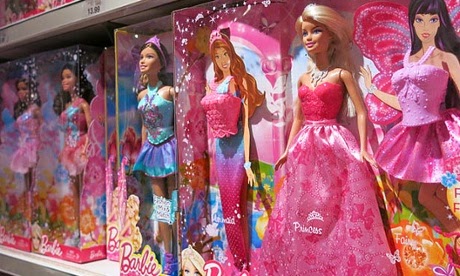It's no surprise sales of Barbie are continuing to fall - she's out of step with the modern world
She may have dated Ken since 1961 but Barbie is now experiencing what it’s like to be left on the shelf. Sales of the doll and related merchandise fell 15% in the three months to June following a 14% drop in the previous quarter.
I’m glad she’s falling out of fashion. I know her warped aesthetic is not responsible alone for women’s body issues but it doesn’t help. She feels out of step with the modern world: not that shrinking world where newspaper executives think it’s still OK to write sexist headlines about the appearance of the women MPs promoted to cabinet this week but the one we want our daughters to inhabit.
Campaigns such as Pink Stinks and Let Toys Be Toys have alerted parents to the genderisation of toys and the negative messages this sends. Other franchises such as Corolle or Lottie dolls, which have a childlike body shape and no makeup or high heels, feel less “girly”.
Barbie’s done her best to keep up with the times. Last month Barbie Entrepreneur was launched, complete with an impressive network of real-life mentors. Toy company Mattel signed up 10 successful businesswomen to be her “Chief Inspirational Officers”. These include Reshma Saujani, the founder of Girls Who Code, a non-profit organisation that aims to teach girls advanced computer skills.
Saujani said: “You can’t be what you can’t see. When you ask a girl what a computer scientist is, she usually pictures a geeky guy typing away. And then we wonder why girls don’t pursue careers in tech! We have to change popular culture and start showing more women, more cool, dynamic, creative women, in these roles.”
Hang on, Entrepreneur Barbie doesn’t look like a woman any seven year old will grow up into either. Unless you’re counting Ukrainian Valeria Lukyanova who became a human Barbie thanks to plastic surgery and a liquid diet (which would leave you far too weak to push all those geeks out of the elevator going up to the boardroom anyway).
According to the sales blurb, Barbie Entrepreneur wears a “sophisticated dress in signature pink... Her ‘smartphone’, tablet and briefcase are always by her side. And luxe details, like a glam necklace, cool clutch and elegant hairstyle, are awesome extras for a smart, stylish career woman”.
Granted, all this is an advancement on the Slumber Party Barbie of the 1960s which along with hair rollers and a sleeping bag came with bathroom scales set at 110lbs, and a small book titled How To Lose Weight whose only words inside were: “DON’T EAT!”
But Barbie Entrepreneur’s shape has not been updated. While the average woman’s figure today is several inches bigger than it was in the 1950s, hers has stayed resolutely tiny. Is she sending a subliminal message to young girls that to have a successful career you have to have a 32” bust, 16” waist and 29” hips? Can you still be a Silicon Valley player measuring a more generous 36-28-38?
And does any of this matter? She’s just a doll, people say, a vehicle for firing a child’s imagination and storytelling skills.
Maybe, but research by Oregon State University (OSU) found that playing with Barbies could limit girls' career choices. Girls aged four to seven were given one of three dolls: a fashion Barbie wearing a dress and high heels; a career Barbie with a doctor’s coat and stethoscope; or a Mrs Potato Head with accessories such as purses and shoes. After a few minutes of play, the girls were asked if they could do any of 10 occupations when they grew up. They were also asked if boys could do those jobs. Half of the careers were traditionally male-dominated and half female-dominated.
Girls who played with Barbie thought they could do fewer jobs than boys could do. But girls who played with Mrs Potato Head cited nearly the same number of possible careers for themselves and for boys. Interestingly, there was no difference in the results between girls who played with a fashion Barbie or a career version of the doll.
“Playing with Barbie has an effect on girls’ ideas about their place in the world,” said Aurora M. Sherman, an OSU psychology professor. “While it’s not a massive effect, it is a measurable and statistically significant effect.”
As Sherman notes, childhood development is complex and having a Barbie among a variety of toys is unlikely to change a girl's career aspirations, even if it may have some influence on her ideas of what that career might be.
But when there are so many other action figures and dolls on sale, why choose Barbie?
Two American businesswomen are planning to manufactureIAmElemental, a collection of strong female characters with names such as Bravery and Persistence. When IAmElemental - which should be on sale at the end of the year - launched on crowdfunding site Kickstarter last month, the project was fully funded within two days – more than 2,500 people have pledged about £100,000 between them, almost five times the original target total.
Sorry Barbie, but you’ve had your day.

.png)


0 comments:
Post a Comment
Grace A Comment!